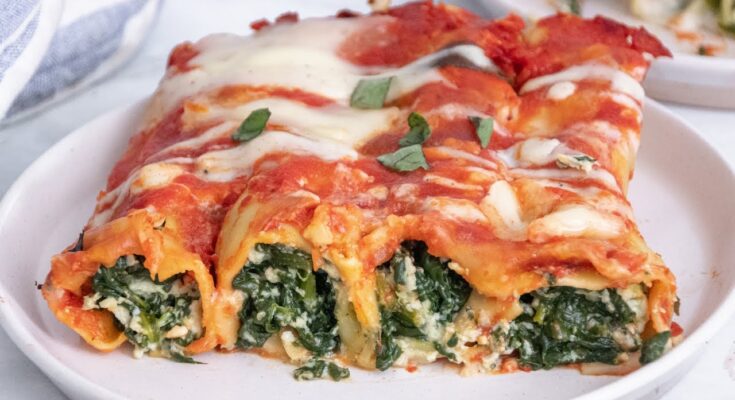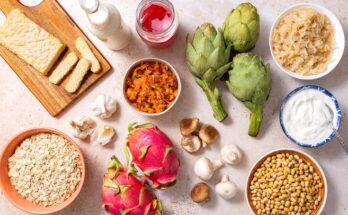Cannelloni Recipe: Cannelloni is one of those comfort dishes that instantly feels like home. Imagine long pasta tubes generously stuffed with a creamy, savory filling, layered with sauce, and baked until golden brown. That’s cannelloni in its simplest form. The word itself comes from the Italian “canna,” meaning reed or tube, perfectly describing the hollow pasta shape. Unlike lasagna, where pasta sheets are stacked, or spaghetti, where sauce is poured over, cannelloni captures the filling inside, making every bite a little parcel of flavor.
What makes cannelloni unique is its versatility. It can be filled with cheese, vegetables, or meats, making it a dish that caters to everyone’s preferences. Whether you’re a vegetarian craving something hearty or a meat lover searching for a fulfilling meal, cannelloni is a dish that adapts beautifully.
The beauty of cannelloni is that it feels sophisticated enough for a dinner party yet comforting enough for a cozy family meal. When baked, the pasta absorbs the flavors of the sauce, and the filling becomes rich and creamy. The end result is a dish that brings warmth to the table and a smile to anyone lucky enough to taste it.
Origins and Popularity of Cannelloni
Cannelloni has its roots deep in Italian tradition, particularly from the regions of Campania and Emilia-Romagna. While the exact origin story varies, food historians often credit Naples with popularizing it in the early 20th century. Before that, Italians used simple pasta sheets, rolling them around fillings by hand, creating the earliest versions of cannelloni.
Over time, cannelloni traveled beyond Italy, winning hearts across Europe and eventually the world. It’s now a classic feature in many Italian restaurants, but making it at home allows for more creativity. You control the filling, the sauces, and even the level of cheesiness.
Today, cannelloni comes in many variations—from classic spinach and ricotta to indulgent meat versions or even seafood. Its global popularity lies in its adaptability, making it a dish that speaks a universal language of flavor.
Why You’ll Love Making Cannelloni at Home
If you’ve ever ordered cannelloni at a restaurant and thought, “This must be hard to make,” you’re not alone. It looks fancy, but in reality, making cannelloni is straightforward once you know the steps. Cooking it at home means you get fresh, oven-to-table cannelloni with no compromises.
Here’s why you’ll fall in love with homemade cannelloni:
- Customization: Choose your filling—spinach and ricotta, beef, chicken, seafood, or even vegan.
- Freshness: Homemade sauce beats anything from a jar.
- Comfort factor: The smell of baking cannelloni instantly makes your kitchen feel warm and inviting.
- Meal prep friendly: You can make a big batch, freeze some, and reheat later for quick weeknight dinners.
So, whether you’re cooking for family, hosting friends, or just craving something hearty, cannelloni will always deliver.
Ingredients You’ll Need
Pasta Sheets vs. Ready-Made Cannelloni Tubes
Before diving into fillings and sauces, let’s tackle the base: the pasta. Cannelloni can be made two ways:
- Ready-Made Tubes: These are pre-shaped pasta tubes available in most grocery stores. They save time but can be a bit tricky to fill if you don’t have the right tools.
- Fresh Pasta Sheets: If you have access to fresh lasagna sheets, you can cut them into rectangles, boil briefly, then roll them around your filling. This method feels more authentic and allows for softer, silkier pasta once baked.
For beginners, ready-made tubes are a lifesaver. For purists, fresh sheets give you that restaurant-style texture.
Ingredients for the Filling
The filling is the heart of cannelloni. Here are some classic options:
- Spinach and Ricotta: A vegetarian favorite, creamy and light.
- Ground Beef or Chicken: For a richer, protein-packed dish.
- Mushrooms & Cheese: A meaty texture without actual meat.
- Seafood Mix: For something elegant and unique.
Base ingredients you’ll often need:
- Fresh spinach or other greens
- Ricotta cheese
- Mozzarella or Parmesan for added flavor
- Ground meat (optional)
- Garlic, onion, and Italian herbs (basil, oregano, thyme)
Ingredients for the Sauce
Two sauces are traditionally used in cannelloni:
- Tomato Sauce: A classic marinara made with tomatoes, garlic, onions, and herbs.
- Béchamel Sauce: A creamy white sauce made with butter, flour, and milk.
You can use just one sauce, but the real magic happens when you layer both. The tomato adds brightness, while the béchamel brings creaminess.
Don’t forget toppings like grated Parmesan or mozzarella for that golden, bubbly crust.
Optional Toppings and Garnishes
A few extras can elevate your cannelloni:
- Fresh basil leaves for garnish
- A drizzle of olive oil before serving
- Crushed red pepper flakes for heat
- Extra Parmesan at the table
Kitchen Tools and Equipment
Must-Have Utensils
To make cannelloni without frustration, you’ll need:
- A large pot for boiling pasta sheets
- A skillet for preparing filling
- Mixing bowls for combining ingredients
- A piping bag or small spoon for stuffing the tubes
- A sharp knife for chopping vegetables or meat
Baking Dish Recommendations
The size of your baking dish matters. Too small, and the cannelloni won’t bake evenly. Too large, and the sauce spreads too thin. A 9×13-inch dish is usually perfect for a family-sized portion. Ceramic or glass baking dishes work best since they retain heat and give you a beautiful golden top.
Tips for Prepping Ingredients Efficiently
Want to make the process smooth? Here are some tips:
- Chop and sauté your filling ingredients ahead of time.
- Prepare sauces the day before and refrigerate.
- Use a piping bag for neat filling—it saves time and keeps your hands clean.
- Grate cheese in advance and store in an airtight container.
Cooking cannelloni can be a relaxing experience if you organize your steps. Think of it as building layers of flavor rather than rushing to finish.
Preparing the Cannelloni Filling
Classic Spinach and Ricotta Filling
This is the most loved filling for a reason—it’s creamy, light, and pairs beautifully with both tomato and béchamel sauces. To make it, sauté fresh spinach with garlic until wilted, then chop finely. Mix it with ricotta, Parmesan, and a hint of nutmeg. This mixture is smooth yet hearty and packs tons of flavor.
The secret is in the balance: too much spinach makes it watery, too much ricotta makes it bland. A 2:1 ratio of ricotta to spinach usually works best.
Meat-Based Filling (Beef or Chicken)
For meat lovers, beef or chicken filling takes cannelloni to another level. Ground beef cooked with onions, garlic, and herbs becomes rich and savory. Chicken works just as well, especially when paired with creamy sauces.
Mix the cooked meat with ricotta or béchamel for a softer texture. This prevents the filling from drying out during baking. Add grated mozzarella inside the filling for that gooey surprise when you cut into it.
Vegan or Dairy-Free Filling Alternatives
Don’t worry if you’re avoiding dairy—vegan cannelloni is just as delicious. Replace ricotta with cashew cream or tofu blended with lemon juice and nutritional yeast. For meat substitutes, mushrooms or lentils provide a hearty bite.
Seasoning is crucial here since vegan alternatives can taste flat without enough herbs. Garlic, basil, oregano, and a drizzle of olive oil can bring everything to life.
Flavor Enhancements and Seasonings
Whether you choose cheese, meat, or veggies, seasoning makes or breaks the filling. Always include:
- Salt and pepper
- Fresh herbs (basil, parsley, or thyme)
- Nutmeg (especially with ricotta)
- Olive oil for richness
These small touches make a huge difference in the final taste.
Making the Perfect Sauce
Homemade Tomato Sauce
A good tomato sauce brings brightness and acidity to balance the richness of cheese and pasta. Start by sautéing onions and garlic in olive oil, then add canned tomatoes (or fresh if in season). Simmer with salt, pepper, and Italian herbs until thick.
For extra depth, add a splash of red wine while simmering.
Creamy Béchamel Sauce
Béchamel is the luxurious counterpart to tomato sauce. Made by whisking butter and flour together, then slowly adding milk, it creates a silky, rich sauce. Season with salt, pepper, and a pinch of nutmeg.
This sauce adds creaminess that makes cannelloni feel indulgent.
Combining Tomato and Béchamel for Balance
Most Italian recipes use both sauces together—tomato on the bottom, béchamel on top. The result is heavenly: tangy and fresh underneath, creamy and smooth above, with pasta and filling tying it all together.
Store-Bought vs. Homemade Sauces
If you’re short on time, you can use store-bought marinara or Alfredo. But honestly, homemade takes just 20 minutes and makes a massive difference in flavor.
Step-by-Step Guide to Assembling Cannelloni
Boiling Pasta Sheets or Using Ready-Made Tubes
This step determines how smoothly your cannelloni comes together. If you’re using fresh lasagna sheets, boil them in salted water for 2–3 minutes until soft but not mushy. Drain and lay them flat on a clean kitchen towel to prevent sticking. You’ll later spread the filling and roll them into tubes.
With ready-made cannelloni tubes, things get easier—you don’t need to boil them. Just make sure your sauce is generous and not too thick, as the pasta will soften while baking. The trick is to ensure enough liquid in the dish to hydrate the pasta fully.
Pro tip: If you’re nervous about undercooking store-bought tubes, you can briefly soak them in hot water before stuffing. This ensures they soften nicely in the oven.
Stuffing Cannelloni Neatly
Stuffing cannelloni is where many people get stuck. The easiest way is to use a piping bag fitted with a wide nozzle. Fill it with your chosen mixture and pipe directly into the tubes. This method ensures the filling is evenly distributed.
If you don’t have a piping bag, use a small spoon or even a zip-lock bag with the corner cut off. The key is patience—avoid overfilling, as this can cause the filling to spill out during baking. Aim to fill each tube about 90% full.
Neatness matters because it helps the dish cook evenly and makes serving much easier.
Layering Sauce and Pasta in the Baking Dish
Now comes the fun part—assembling! Grease your baking dish lightly with olive oil. Start by spreading a thin layer of tomato sauce at the bottom to prevent sticking. Arrange your filled cannelloni tubes in a single layer.
Once the first layer is done, cover generously with tomato sauce, followed by béchamel sauce. Repeat if you’re making multiple layers. The goal is to keep the pasta fully covered in sauce so it absorbs moisture during baking.
Finally, top everything with grated mozzarella and Parmesan. The cheese will melt into a bubbly, golden crust.
Baking Tips for a Perfect Golden Top
Preheat your oven to 375°F (190°C). Cover the dish with aluminum foil for the first 25–30 minutes to allow the pasta to cook without drying out. Then, remove the foil and bake uncovered for another 15 minutes.
This two-step process ensures the pasta softens and the cheese browns beautifully. For extra crunch, switch on the broiler for the last 3–4 minutes.
Once baked, let the cannelloni rest for 10 minutes before serving. This helps the filling set and makes it easier to slice neatly.
Serving Suggestions
Side Dishes That Pair Well
Cannelloni is rich, so pairing it with lighter sides makes the meal balanced. Great options include:
- A crisp green salad with lemon vinaigrette
- Garlic bread or focaccia for soaking up extra sauce
- Roasted vegetables like zucchini, bell peppers, or asparagus
The idea is to complement the heaviness of the pasta with freshness and crunch.
Wine Pairings
Nothing completes Italian food like wine. For spinach and ricotta cannelloni, a crisp white wine such as Pinot Grigio works beautifully. For meat-based cannelloni, go for a bold red like Chianti or Cabernet Sauvignon.
If you’re avoiding alcohol, sparkling water with lemon makes a refreshing companion.
Presentation Tips for Guests
If you’re serving cannelloni at a dinner party, presentation goes a long way. Garnish with:
- Fresh basil or parsley leaves
- A drizzle of extra virgin olive oil
- A sprinkle of Parmesan right before serving
Serve in individual portions for an elegant touch. Cannelloni looks impressive straight from the oven, so bring the dish to the table—it’s a showstopper.
Variations of Cannelloni
Seafood Cannelloni
For a luxurious twist, try seafood cannelloni filled with crab, shrimp, or a mix of white fish. Combine the seafood with a light béchamel or cream cheese filling. Pair it with a lemony tomato sauce for freshness.
This variation is lighter than meat but still indulgent—perfect for special occasions.
Vegetarian Cannelloni
Spinach and ricotta may be the classic, but there are endless vegetarian options. Some delicious choices include:
- Roasted pumpkin and sage
- Mushroom and béchamel
- Zucchini and goat cheese
Adding roasted vegetables gives the dish a sweet, earthy flavor. It’s proof that vegetarian food can be just as hearty as meat dishes.
Gluten-Free Cannelloni
For those avoiding gluten, look for gluten-free pasta tubes available in many supermarkets. Alternatively, use thin slices of zucchini or eggplant as a pasta substitute. Roll the filling inside and bake as usual—this version is lighter and low-carb.
Regional Italian Variations
Different parts of Italy add their own flair to cannelloni:
- Naples: Meat-heavy fillings with rich tomato sauce.
- Tuscany: Lighter fillings with fresh herbs and simple sauces.
- Northern Italy: More béchamel, creamy cheeses, and sometimes even truffle oil.
These variations highlight how adaptable cannelloni is—it’s a dish that evolves with every kitchen.
Common Mistakes and How to Avoid Them
Overcooking the Pasta
Cannelloni should be tender but not mushy. Avoid boiling pasta sheets for too long and keep an eye on oven baking times. If using ready-made tubes, ensure your sauce has enough liquid to cook the pasta properly.
Watery Sauce Issues
A watery filling or sauce can ruin the texture. To fix this:
- Drain spinach well after cooking.
- Let meat fillings cool before mixing with cheese.
- Simmer tomato sauce until thick before layering.
This ensures your cannelloni comes out creamy, not soupy.
Uneven Cooking Problems
Sometimes, the middle cannelloni stays undercooked while the edges are perfect. To prevent this, spread sauces evenly and don’t overcrowd the dish. Covering with foil also helps distribute heat better.
Keeping Filling Intact
If your filling spills out, it usually means overstuffing or using pasta that’s too dry. Stick to the 90% rule when filling and always cover generously with sauce to keep everything sealed.
Tips for Storing and Reheating
Refrigeration Guidelines
Cannelloni tastes just as good the next day—sometimes even better because the flavors deepen overnight. If you plan to refrigerate, let the dish cool completely before covering it with plastic wrap or transferring it into an airtight container. Refrigerated cannelloni stays fresh for up to 3 days.
When reheating, add a spoonful of sauce or a splash of milk to prevent the pasta from drying out. Cover with foil and bake at 350°F (175°C) for about 20 minutes, or until heated through.
Freezing Cannelloni
One of the best things about cannelloni is how well it freezes. You can freeze it before or after baking:
- Before Baking: Assemble everything in a freezer-safe dish, cover tightly with foil, and freeze. When ready, bake straight from frozen at 375°F (190°C) for 45–50 minutes.
- After Baking: Let the dish cool, portion it into airtight containers, and freeze for up to 2 months. Reheat in the oven or microwave when needed.
This makes cannelloni a perfect meal prep option for busy weeks.
Best Reheating Methods Without Drying Out
The trick to reheating cannelloni is keeping it moist. The oven method works best, but if you’re short on time, the microwave works too. Just cover the portion with a damp paper towel to keep the pasta soft and prevent it from turning rubbery.
Avoid reheating uncovered or on high heat, as this dries out the sauce and hardens the pasta.
Nutritional Value of Cannelloni
Calorie Breakdown
Cannelloni is indulgent, but knowing the nutrition helps you enjoy it guilt-free. On average, one serving (about two tubes with sauce) contains:
- Calories: 400–500
- Protein: 20–25g (higher with meat filling)
- Carbohydrates: 35–40g
- Fat: 18–22g (depends on cheese and sauce)
This makes it a hearty, satisfying meal that provides both comfort and energy.
Protein and Carbohydrate Content
Protein content depends on your filling choice. Meat and seafood add more protein, while vegetarian versions rely mostly on cheese. Carbohydrates mainly come from the pasta, which gives the dish its comforting, filling quality.
For athletes or those with high energy needs, meat-based cannelloni is an excellent option. For a lighter version, opt for spinach and ricotta or even zucchini roll-ups.
Healthier Alternatives and Adjustments
If you’re watching your diet, small adjustments make cannelloni healthier without sacrificing taste:
- Use whole wheat pasta for extra fiber.
- Swap ricotta with low-fat cottage cheese.
- Replace heavy béchamel with a lighter version made from olive oil and skim milk.
- Add more vegetables like mushrooms, zucchini, or kale to bulk up the filling.
These tweaks allow you to enjoy cannelloni more often without feeling weighed down.
Cooking Cannelloni for Special Diets
Low-Carb or Keto Versions
For those on a low-carb diet, pasta sheets can be swapped with thinly sliced zucchini or eggplant. Roast them lightly before rolling with filling to make them pliable. This version is lighter, fresher, and fits perfectly into a keto lifestyle while still offering that baked comfort food experience.
Vegan and Plant-Based Adaptations
Vegan cannelloni is just as delicious as traditional versions. Use tofu, cashews, or even plant-based ricotta as the base filling. Add nutritional yeast for a cheesy flavor without dairy. For the sauce, swap béchamel with a creamy almond milk or oat milk version.
Plant-based cannelloni is full of flavor, hearty, and proves that Italian comfort food can be fully vegan without compromise.
Allergy-Friendly Options
If you’re cooking for guests with allergies, consider these adjustments:
- Gluten-free: Use gluten-free pasta tubes or veggie slices.
- Dairy-free: Swap cheese with vegan alternatives made from nuts or soy.
- Nut-free: Stick to classic dairy-based fillings or use soy-based vegan cheeses.
Cannelloni can easily adapt to dietary needs, making it an inclusive dish for gatherings.
FAQs about Cannelloni Recipe
1. Can I use lasagna sheets instead of cannelloni tubes?
Yes, just cut fresh lasagna sheets into rectangles, blanch them, and roll them around your filling.
2. How long does cannelloni take to bake?
Usually 40–45 minutes at 375°F (190°C), with the first half covered and the last half uncovered.
3. Is cannelloni better with béchamel or just tomato sauce?
Both work, but combining them gives the best balance of tangy and creamy flavors.
4. Can I make cannelloni without cheese?
Absolutely! Try vegan fillings like mushroom-lentil mixtures or cashew-based creams.
5. What is the best way to freeze cannelloni?
Assemble it, cover tightly, and freeze before baking. This way, you can bake it fresh when needed.
Conclusion
Cannelloni is the ultimate comfort dish—rich, cheesy, and endlessly versatile. From classic spinach and ricotta to meat, seafood, or vegan versions, it adapts to every taste and occasion. Making cannelloni at home might look intimidating, but with the right steps, it’s surprisingly simple.
The key lies in layering flavors: a flavorful filling, a balanced sauce, and that golden cheesy crust. With tips for storing, reheating, and adapting to special diets, this dish can fit into anyone’s lifestyle.
Whether you’re cooking for family, impressing guests, or preparing meals ahead of time, cannelloni never disappoints. It’s more than food—it’s a dish that brings people together, one bite at a time.



